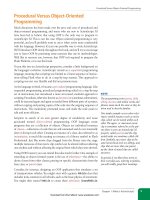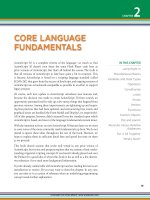Học Actionscript 3.0 - p 3 pot
Bạn đang xem bản rút gọn của tài liệu. Xem và tải ngay bản đầy đủ của tài liệu tại đây (4.72 MB, 10 trang )
Preface
xix
Colophon
Our look is the result of reader comments, our own experimentation, and
feedback from distribution channels. Distinctive covers complement our
distinctive approach to technical topics, breathing personality and life into
potentially dry subjects. The text font is Linotype Birka; the heading font is
Adobe Myriad Pro.
Download from Wow! eBook <www.wowebook.com>
Download from Wow! eBook <www.wowebook.com>
1
IN THIS PART
Chapter 1
ActionScript Overview
Chapter 2
Core Language
Fundamentals
GettinG Started
PART
I
Part I starts this book off with a collection of basic overviews, spanning
Chapters 1 and 2. It begins with a survey of ActionScript, providing a list of
new feature highlights, a brief explanation of procedural versus object-oriented
programming, and gets you started right away with your first script.
It concludes with a review of core language fundamentals, most of which
remain consistent across all versions of ActionScript. The material at the out-
set of the book serves as an introduction to ActionScript for those new to the
language, or as a refresher for those already familiar with it, and allows you
to focus later on ActionScript 3.0–specific syntax.
Download from Wow! eBook <www.wowebook.com>
Download from Wow! eBook <www.wowebook.com>
3
IN THIS CHAPTER
What’s New in
ActionScript 3.0?
The Flash Platform
Procedural Versus Object-
Oriented Programming
The Document Class
Legacy Code Compatibility
Hello World
What’s Next?
While you likely know that ActionScript is the main scripting language of
the Flash Platform, and you’re no doubt eager to begin working with the new
version, a brief overview of its development will give you some insight into
its use—particularly as related to Flash Player and how it handles different
versions of ActionScript. This brief introductory chapter will give you a quick
look at where ActionScript 3.0 fits into your workflow.
Before we get started, it might help to understand how you get from
ActionScript code to a finished file that you can put into a website. If this isn’t
news to you, bear with us for just a paragraph or two.
When you publish a Flash file—using Flash Professional’s File
→Publish or
Control
→Test Movie—all of the internal graphics and other assets used in
your movie, as well as all of the ActionScript code, are compiled into a final
file format called a SWF (pronounced “swiff” or “S-W-F”). That is, a part of
your Flash Platform application of choice (such as Flash Professional) con-
tains software called the compiler. This software converts all of your human-
readable scripts into an optimized, machine-readable format. It combines
that code with your assets into a single SWF file that Flash Player can decode
and play back for all to see.
Although your SWF can load external assets not already compiled into your
SWF (such as an MP3 or a video), any asset that you imported or embedded
and all scripts—even if they originate outside the FLA (pronounced “flah”
or “F-L-A”) file—must go through this compilation process to be included
in the SWF. This is why you must publish a new SWF every time you make
a change to your code. It’s also why you don’t have to distribute ActionScript
files with your SWF, even if you created external files, such as classes, when
coding. Distributing ActionScript files with your SWF won’t affect playback,
but it may expose your source code to the public. This is fine when you’re
contributing code for others to learn from, but it won’t make a client happy
if you’re doing work for hire!
What Is
aCtIonsCrIPt?
CHAPTER
1
Download from Wow! eBook <www.wowebook.com>
Part I: Getting Started
4
For most users, the compilation process occurs behind the scenes and is
handled by Flash Professional. At the time of this writing, the current version
is Flash Professional CS5, but most of this book is compatible with versions
dating back to Flash Professional CS3.
Other applications, such as Adobe’s Flash Builder (or its predecessor Flex
Builder), Power Flasher’s FDT, the open source FlashDevelop, and even
text editors in combination with a command-line compiler, can transform
ActionScript into SWFs. However, this book focuses primarily on Flash
Professional as an ActionScript editor.
Many examples will work seamlessly in any ActionScript editor; other exam-
ples will rely on symbols found in the library of a sample Flash file (FLA).
This will be discussed briefly in the “Flash Platform” section of this chapter,
but be sure you’re comfortable with this workflow before investing any time
in these examples. If your primary goal is to become a Flex developer, for
example, with an equal emphasis on that technology’s MXML syntax, you
may want to pick up a companion to this text that focuses more significantly
on Flex, such as Learning Flex 4 (O’Reilly).
• What Is ActionScript 3.0? Every new version of ActionScript intro-
duces new features. ActionScript 3.0, however, was written from scratch
(not built on prior versions of the language) and is handled entirely
separately from previous versions of ActionScript anywhere the language
is used. This intentional branching allows for syntax improvements and
significantly improves performance, but also makes it more difficult to
use multiple versions of ActionScript at the same time.
• The Flash Platform. ActionScript 3.0 can be used in Flash, Flex projects,
and AIR (Adobe Integrated Runtime) desktop applications, each of which
are part of what is collectively known as the Flash Platform. Although
they affect only a small portion of the language, differences in these envi-
ronments prevent ActionScript 3.0 from working exactly the same way in
every application that is part of the Flash Platform. The fundamentals,
however—indeed, the bulk—of the language, are the same throughout.
• Procedural Versus Object-Oriented Programming. A lot of attention
has been focused on the object-oriented programming (OOP) capa-
bilities of ActionScript 3.0, and the language’s power really shines in this
area. However, embracing ActionScript 3.0 doesn’t mean that you must
become an expert in OOP. Using Flash, it is still possible to write scripts
in the timeline, using functions to organize more complex code. This is
commonly called procedural programming. If you prefer object-oriented
programming, enhancements to ActionScript’s OOP structure make ver-
sion 3.0 more robust and bring it more in line with the features of other
OOP-based languages (such as Java). This also makes moving between
such languages a bit easier.
What Is ActionScript?
Download from Wow! eBook <www.wowebook.com>
What’s New in ActionScript 3.0?
Chapter 1: What Is ActionScript?
5
• The Document Class. Object-oriented programming is not for every-
one, but for those starting on the OOP journey, Flash offers a simple step-
ping off point in the Document class. Using this feature, you need only
specify an external ActionScript class file as your starting point, and no
timeline script is required.
• Legacy Code Compatibility. Because ActionScript 3.0 can’t mingle with
previous versions of the language in the same file, developing projects
that support older code is a challenge. We’ll briefly introduce the issues
involved and point to a technique that makes possible some communica-
tion between ActionScript versions.
• Hello World. This chapter will conclude with you writing your first
ActionScript 3.0 application. We’ll dive into some syntax for text manip-
ulation, but don’t worry: we’ll cover the material in more detail in a
later chapter. This exercise is just to get you started and build a little
confidence.
What’s New in ActionScript 3.0?
If you’re familiar with ActionScript or you’re learning it based on experi-
ence with another programming language, you may want to know what
ActionScript 3.0 has to offer. Although the third major version of the Flash
Platform’s primary scripting language contains much that will be familiar
to users of prior versions, it’s probably best to think of ActionScript 3.0 as
entirely new, for a few simple reasons.
First, a few things are quite different, such as how events are handled and
the way assets are displayed. Second, subtle changes run throughout the lan-
guage. (These are usually small concerns, such as a slight change in the name
of a property, but if you are used to ActionScript 2.0, for example, old habits
can die hard.) Most importantly, ActionScript 3.0 has been rewritten from the
ground up and uses a different code base than prior versions of the language.
This optimization provides relatively dramatic performance increases, but it
means that ActionScript 3.0 code cannot be mixed with prior versions of the
language in the same file.
Regardless of your experience level, don’t let the newness of ActionScript 3.0
intimidate you. It’s true that its learning curve is steeper than that of prior ver-
sions, but that is usually a function of its robustness more than one of difficul-
ty. Typically, whether you are coming to ActionScript 3.0 from a prior version
of ActionScript or another language altogether, there is an adjustment period
during which users must occasionally adapt to a new way of doing things.
Download from Wow! eBook <www.wowebook.com>
Part I: Getting Started
6
What’s New in ActionScript 3.0?
Here’s a look at some of the highlights of ActionScript 3.0. Keeping these
benefits in mind may help make it easier to learn a robust language, or accept
change—particularly when that change may initially seem tedious or overly
complicated. Select new features include:
Detailed error reporting
ActionScript 3.0 supports strict data typing of variables, arguments, values
returned from functions, and so on. Chapter 2 discusses data typing in
depth, but it boils down to telling the compiler and Flash Player which
kind of data you want to work with at different points within your proj-
ect code. This allows the compiler to warn you if you use the wrong data
type, catching related errors. ActionScript 3.0 supports static data type
checking, which occurs at compile time (when publishing your SWF),
and improves dynamic data type checking, which checks for errors at run-
time. In ActionScript 3.0, errors will no longer fail silently. Understanding
this fully in this overview isn’t important, and the benefits of data typing
will become apparent after reading Chapter 2—and even more so after
gaining a little experience with ActionScript 3.0. For now, just take heart
knowing that error checking and reporting are more vigilant than in any
prior version of ActionScript.
Syntax improvements
Syntax issues have been unified and cleaned up throughout the language.
For instance, some property names have been clarified and made con-
sistent by removing leading underscores. (Setting the x coordinate of a
movie clip, for example, now uses
x instead of _x.). Also, former multiple
and varying ways of approaching the same or similar tasks have been
simplified and made consistent.
New display architecture
The many previous approaches to displaying assets are now consolidated.
ActionScript 3.0 has simplified how visible assets, such as movie clips and
text fields, are handled, using a new display architecture called the display
list. Chapter 4 examines this major change introduced by ActionScript 3.0.
New event architecture
Still another example of improved consistency, all events—such as a
mouse click or key press—are handled by event listeners in ActionScript
3.0—essentially listening for a specific event to occur, and then reacting
accordingly. The new event model is very powerful when combined with
the display list, allowing mouse and keyboard events to propagate through
multiple display objects. The event model is discussed in Chapter 3.
Improved XML handling
Working with complex XML documents is a pleasure with ActionScript 3.0.
It allows you to reference XML data the same way you reference properties
of other objects, such as movie clips or buttons, using a similar syntax.
Download from Wow! eBook <www.wowebook.com>
What’s New in ActionScript 3.0?
Chapter 1: What Is ActionScript?
7
You’ll learn more about this in Chapter 14, but a simple example is refer-
ring to an XML node called phone, nested inside a node called user, as
user.phone. This is comfortable territory when you remember that a
movie clip called mc2, nested inside a movie clip called mc1, is referenced
as
mc1.mc2.
Additional text options
New text-processing options now allow for much finer control over text
manipulation. For example, you can now find the contents of a particular
line in a text field, the number of characters in that line, and the char-
acter at a specified point (such as under the mouse). Flash Professional
CS5 also introduces a brand new text feature called the Text Layout
Framework (TLF). This new engine provides a greater degree of text con-
trol, including traditional typographic features, automatic text flow, and
even support for right-to-left and vertical text layouts and double-byte
languages (such as Chinese, Japanese, and Korean, among others). Text is
discussed in Chapter 10.
More sound management options
ActionScript 3.0’s sound capabilities are among the jazziest changes to
the language. On a practical level, they improve programmatic control
over both individual sounds and all sounds playing. Sounds are now
placed into separate channels, making it easier to work with more than
one discrete sound. Sounds are also funneled through a sound mixer for
collective control. You can get the amplitude and frequency spectrum data
from sounds during playback, as well as from microphone input. Chapter
11 covers sound in detail.
New access to raw data
For more advanced needs, you can access raw binary data at runtime.
Individual bytes of data can be read during download, during sound
playback, or from bitmap data, to name a few examples. These bytes can
be stored in a large list and still be accessed quickly and efficiently. We’ll
show an example of this technique in Chapter 11 when discussing sound
visualization.
New automatic scope management
In a programming language, the word scope is sometimes used to define
the realm in which an object, such as a movie clip, lives. A movie clip
might exist in one part of a Flash movie but not another. For example, a
child movie clip might be nested inside one of two movie clips found in
the main timeline. That nested movie clip exists within one clip but not
the other. Its scope, therefore, is restricted to the movie clip in which it
lives, or its parent. Programming structures have specific scopes, as well,
and ActionScript 3.0 greatly simplifies this concept by automatically keep-
ing track of where a particular block of code was defined—so you don’t
have to.
Download from Wow! eBook <www.wowebook.com>
Part I: Getting Started
8
The Flash Platform
Improved object-oriented programming
If you’re familiar with object-oriented programming, you’ll be glad to
know that ActionScript 3.0 supports this structure well. If you’re new to
OOP, don’t worry: we’ll introduce it in this book at a comfortable pace.
We’ll focus on syntax throughout by using simple examples, and we’ll
start to discuss OOP in greater detail in Chapter 6. If you’re already
familiar with OOP, you may be happy to know that sealed classes and
new namespaces, among other things, have been added to ActionScript
3.0. Most classes are sealed by default, meaning the compiler recog-
nizes only those properties and methods defined at compile time. This
improves memory usage and performance. However, if you need to add
properties to an instance of a class at runtime (for example), you can still
use dynamic classes such as the
MovieClip and Object, and you can make
your own custom classes dynamic. Additionally, namespaces, including
the ability to define custom namespaces, allow finer control over classes
and XML manipulation.
The Flash Platform
It’s important to note that this book focuses primarily on developing
ActionScript 3.0 applications using the Flash Professional application (also
commonly referred to as an integrated development environment, or IDE).
However, ActionScript 3.0 is the programming language used in Flash
Platform technologies, as well—notably AIR and Flex.
AIR is the Adobe Integrated Runtime application, a sophisticated way of
delivering your applications to the computer desktop, rather than through a
web browser. Flex is another technology for creating SWFs that includes not
only the ActionScript 3.0 language, but also MXML, a tag-based language that
is part of what is commonly called the Flex Framework. This book will not
discuss MXML or the Flex Framework at all, but most of the ActionScript
you learn herein can be used in ActionScript-only Flex projects.
The existence of AIR and Flex means that the scripting skills you develop
using Flash Professional will be largely applicable in other areas of the Flash
Platform, extending your reach as a programmer. There are, however, some
differences between these technologies that are important to understand
when examining the big picture of cross-application scripting.
For instance, each technology adds some features that are not available to
the others. Using a feature that is specific to AIR or Flex, for example, means
that your code may not compile in Flash Professional. The thing to keep in
mind is that the ActionScript 3.0 language skills you develop will ease your
move between these applications and even allow you to work with different
authoring tools or compilers to create your finished product.
N OT E
AIR projects can also be created from
HTML, JavaScript, and PDF, but
ActionScript 3.0 is a large part of its
appeal and the language most relevant
to this discussion.
N OT E
This book is written for readers who
have some familiarity with scripting
but are new to ActionScript 3.0, and it
assumes a working knowledge of the
Flash Professional interface. See the
Preface for more information about this
expectation.
While virtually all of the code in the
book applies to any tool that sup-
ports ActionScript 3.0, some of the
examples use assets that are embedded
within FLA files—the main document
format used by Flash Professional.
The companion website, http://www.
LearningActionScript3.com, contains
information about using the examples
with applications other than Flash
Professional. See the “Using the Book
Examples” post as a starting point for
learning more about this process.
Download from Wow! eBook <www.wowebook.com>









